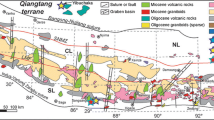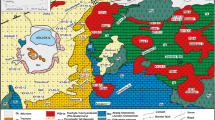Abstract
Crustal xenoliths from basanitic dikes and necks that intruded into continental sediments of the Cretaceous Salta Rift at Quebrada de Las Conchas, Provincia Salta, Argentina were investigated to get information about the age and the chemical composition of the lower crust. Most of the xenoliths have a granitoid composition with quartz-plagioclase-garnet-rutile ± K-feldspar as major minerals. The exceedingly rare mafic xenoliths consist of plagioclase-clinopyroxene-garnet ± hornblende. All xenoliths show a well equilibrated granoblastic fabric and the minerals are compositionally unzoned. Thermobarometric calculations indicate equilibration of the mafic xenoliths in the granulite facies at temperatures of ca. 900 °C and pressures of ca. 10 kbar. The Sm-Nd mineral isochron ages are 95.1 ± 10.4 Ma, 91.5 ± 13.0 Ma, 89.0 ± 4.2 Ma (granitoid xenoliths), and 110.7 ± 23.6 Ma (mafic xenolith). These ages are in agreement with the age of basanitic volcanism (ca. 130–100 and 80–75 Ma) and are interpreted as minimum ages of metamorphism. Lower crustal temperature at the time given by the isochrons was above the closure temperature of the Sm-Nd system (>600–700 °C). The Sm-Nd and Rb-Sr isotopic signatures (147Sm/144Nd = 0.1225–0.1608; 143Nd/144Ndt 0 = 0.512000–0.512324; 87Rb/86Sr = 0.099–0.172; 87Sr/86Srt 0 = 0.708188–0.7143161) and common lead isotopic signatures (206Pb/204Pb = 18.43–18.48; 207Pb/204Pb = 15.62–15.70; 208Pb/204Pb = 38.22 –38.97) of the granitoid xenoliths are indistinguishable from the isotopic composition of the Early Paleozoic metamorphic basement from NW Argentina, apart from the lower 208Pb/204Pb ratio of the basement. The Sm-Nd depleted mantle model ages of ca. 1.8 Ga from granitoid xenoliths and Early Paleozoic basement point to a similar Proterozoic protolith. Time constraints, the well equilibrated granulite fabric, P-T conditions and lack of chemical zoning of minerals point to a high temperature in a crust of nearly normal thickness at ca. 90 Ma and to a prominent thermal anomaly in the lithosphere. The composition of the xenoliths is similar to the composition of the Early Paleozoic basement in the Andes of NW Argentina and northern Chile. A thick mafic lower crust seems unlikely considering low abundance of mafic xenoliths and the predominance of granitoid xenoliths.
Similar content being viewed by others
Author information
Authors and Affiliations
Additional information
Received: 21 July 1998 / Accepted: 27 October 1998
Rights and permissions
About this article
Cite this article
Lucassen, F., Lewerenz, S., Franz, G. et al. Metamorphism, isotopic ages and composition of lower crustal granulite xenoliths from the Cretaceous Salta Rift, Argentina. Contrib Mineral Petrol 134, 325–341 (1999). https://doi.org/10.1007/s004100050488
Issue Date:
DOI: https://doi.org/10.1007/s004100050488




